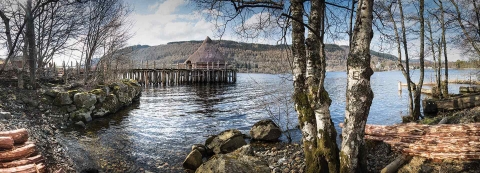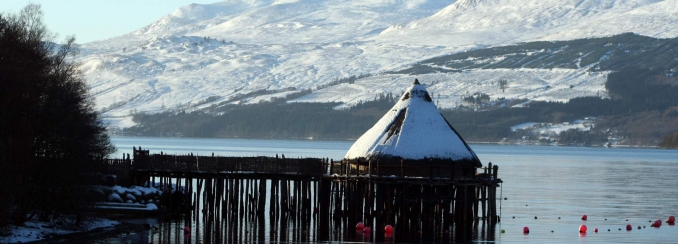Plans to develop new state-of-the-art Scottish Crannog museum one step closer

It has been announced that plans for a £6m project to redevelop the Scottish Crannog Centre on the north shore of Loch Tay are one step closer to being realised, thanks to Forestry and Land Scotland’s Community Asset Transfer Scheme. A news release from Forestry and Land Scotland (FLS) (Scottish Gaelic: Coilltearachd agus Fearann Alba) confirmed that the Scottish Crannog Centre's application had been successful. The project's aims include plans for multiple crannogs that will become the focal point of a new state-of-the-art museum.
Crannogs are a type of ancient loch-dwelling found throughout Scotland and Ireland. The earliest loch-dwelling in Scotland is some 5,000 years old but people built, modified and re-used crannogs in Scotland up until the 17th century AD. Some prehistoric crannogs were originally timber-built roundhouses supported on piles or stilts driven into the loch bed. Others were created by piling tons of rock onto the loch bed to make an island on which to build a stone house. There are several hundred examples of this in Scotland, although today such crannogs appear as tree-covered islands or remain hidden as submerged stony mounds.
Loch Tay (Scottish Gaelic, Loch Tatha) is a freshwater loch in the central highlands of Scotland where more than 20 submerged crannogs have been found. Long and narrow the loch is about around 14.55 miles (23.42 km) long, around 1 to 1½ miles wide, and over 490 ft (150 m) deep in places. Loch Tay has a long history of human use and settlement. It is on the south side of Loch Tay that the present reconstruction of one of these ancient loch dwellings can be visited at the Scottish Crannog Centre.
The successful application will see a 4ha site on the north shore of Loch Tay, known as the Dalerb, which is opposite to the existing Crannog Centre, transferred to the Crannog’s governing Trust. The project includes the creation a new unique museum with multiple crannogs. Scottish Crannog Centre MD, Mike Benson, said:
“Over the past 20 years, the Scottish Crannog Centre has developed from its origins as part of a research project carried out on Loch Tay by the pioneering underwater archaeologist Dr. Nick Dixon OBE, to become an internationally recognised and hugely popular attraction.
“I doubt anyone would have anticipated back then just how successful the museum would become. So successful, in fact that the current site is just too small, both to cope with the thousands of visitors we get every year and to cope with our plans to expand."
Images: Scottish Crannog Centre courtesy of SCC






